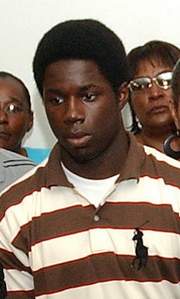Bishop J L George
Founder
-------------
Khalid al-Sharif
special assisting liaison
one.louisianajustice@1lajustice.net
The Louisiana Statewide Civil Rights Conference & Forum met in October of 2007 at Bethel AME Church in Alexandria, Louisiana. This is a report of its findings as to the status of the civil rights apparatus in the state of Louisiana.
1.) - There is not a continuity of involvement from all areas of organized
entitites.
Solute: Advocacy Training.
2.) - The legal community is very slow in accepting certain prima fasci cases
involving the government of the state, where breeches of the law are
evident.
Solute: Self-supported Civil Law Suits filed by the victims of family
of person so victimized.
3.) - The appearances are such that, it may be that the judiciary, the prose-
cution & the defense are basicly colluded in the mass imprisonment of
all parties, across racial lines, and gender; but specifically so amongst
black males & black male youth categorically! A genocide is in place.
Solute: Civil Suits against known party(s). State Legislative hearings.
4.) - The federal government, the Department of Justice, the FBI, the State
Police of Louisiana, the Louisiana Supreme Court et al; have abandoned
the poor to fend for themselves in a untra-conservative, neocon eviron-
ment of fascist, nazi-ist white supremacist controlled society. Case
in point the McZeal-noose incident in Ruston, Louisiana; where the
government flipped the accusation against the victim-McZeal, in which
the FBI accused McZeal of planting the Noose in his locker himself. The
FBI agents in charge were out of Monroe. Mr. McZeal, along with his
mother & others turned himself in, in late November to be charged with
theft over 500 dollars: in which such, he was given at the early Novem-
ber interrogation the opportunity to confess, that he planted the noose
in his work locker himself.
Solute: Congressional Investigations
*WHO THEN NOW WOULD WANT TO TALK WITH FBI ABOUT ANY CONCERN OF A PERSON ABOUT HATE CRIMES, IF; YOU ARE A BLACK MALE!!
5.)- The Louisiana State Penal System is a serious problem that must be
addressed immediately. Inmates are being beaten, left to die in the
case of Lawrence Cole of Calcasieu parish;- in the case of Greg
"Lil Greg" Wilkins in North-central Louisiana was, now sick from
food poisoning that led to seizures. Lawrence Cole died of seizures,
that culminated
in an aneursym, that killed him! The incident occurred January 27th 2007,
in Calcasieu Parish Prison.
*Michael Jarvis Cobb remains in Angola State Penitentiary.
Solute: State Legislative Hearings in to the Penal System.
6.)- Lekeithen Shondell Harris of Glenmora represents the quintessential
problem with the so-called criminal justice system. In 2004 an attorney
"entered into an alledged stipulation with the prosecution in this case,
and the alledged stipulation apparently had the affect of waiving some
his rights, as provided for in the code of criminal procedure and/or the
criminal code itself, . . ..."
This deceitful act is in play all over the state of Louisiana. The
Louisiana Supreme Court, evidently is aware of it. The Office of
Disciplinary Counsel is the entity to curtail such actions.
This defect was in the Mychal Bell Case, in the 28th Judicial District
is possibly ongoing in the Michael Newton Jr., case of Coushatta and was
apparently practiced in the Michael Jarvis Cobb case of Pointe
Coupee's 18th Judicial District.
Solute:- Legislative Hearings pursued by the Louisiana Legislative
Black Caucus, Katrina Jackson - Executive Director; State
Legislator Juan LaFonta - Chairman
*A bill sponsored by a legislator in the Governor-elects upcoming
Special Session on Ethics.
7.)- Statewide will pursue a new cabinet level position enacted in to law, to
specificly handle Judicial Oversight from the Executive Branch. In parti-
cular, Ville Platte, Louisiana has received the purview of the US
Attorney. News accounts relate that, DoJ's CRS, will become involved.
1LaJustice is in Ville Platte, with the Laurence Wilson sentencing on
8 (eight) rapes for 35 years. A Pastor's son was shot in the face,
murdered; as the assailant pleaded down to 25 years. The Pastor's
sons murder is black on black. The 8 rape case in black on white and
decades old.
*The disparity is such that no one can deny the absolute. The Jena
situation continues with the arrest of juvenile Justin Purvis, the
boy who originally asked the question of sitting under the tree.
A 9 (nine) year old boy was brow beat, to the point of mentioning
Justin Purvis' name. There is a connect to the Jena Six
Travesty.
*This is the* December 30th final Draft of the findings of the Louisiana Statewide Civil Rights Conference & Forum - Bishop J L George Founder -&- Khalid al-Sharif special assisting liaison for global affairs & Deputy Adjutant of One Louisiana Justice.
 ------------------->Desperate determination------->
------------------->Desperate determination------->Queriza Lewis Convicted as Habitual Offender in Crack Case in the infamously unjust Louisiana Courts! In addition, threats have been made against his life in the notorious Angola State Penitentiary.
 Mr. Lewis's Mother & family are extremely aware of the disparities in the judicial process, as is the family of Michael Cobb of New Roads & the family of Michael Newton, Jr., of Coushatta. The Spears family of Bunkie, Louisiana are also aware of the desparities of the so-called, "Justice System". All of these individuals & families are held captive by a corrupt process.
Mr. Lewis's Mother & family are extremely aware of the disparities in the judicial process, as is the family of Michael Cobb of New Roads & the family of Michael Newton, Jr., of Coushatta. The Spears family of Bunkie, Louisiana are also aware of the desparities of the so-called, "Justice System". All of these individuals & families are held captive by a corrupt process. -Determination-
-Determination-CRACK VS. POWDER COCAINE ANALYZED:Disparity central
By DENISE LAVOIE, Associated Press Writer
Tue Dec 25, 2:33 AM ET
BOSTON - During some of the bloodiest years of the drug wars of the 1980s, crack was seen as far more dangerous than powdered cocaine, and that perception was written into the sentencing laws. But now that notion is under attack like never before.
Criminologists, doctors and other experts say the differences between the two forms of the drug were largely exaggerated and do not justify the way the law comes down 100 times harder on crack.
A push to shrink the disparity in punishments got a boost last month when reduced federal sentencing guidelines went into effect for crack offenses. Then, earlier this month, the U.S. Sentencing Commission, which sets guidelines for federal cases, voted to make the reductions retroactive, allowing some 19,500 inmates, mostly black, to seek reductions in their crack sentences.
Many think the changes are long overdue.
Crack, because it is smoked and gets into the bloodstream faster than snorted cocaine, produces a more intense high and is generally considered more addictive than powdered cocaine.
But experts say that difference does not warrant the 100-to-1 disparity that was written into a 1986 law that set a mandatory minimum prison term of five years for trafficking in 5 grams of crack, or less than the amount in two packets of sugar. It would take 100 times as much cocaine to get the same sentence.
"There's no scientific justification to support the current laws," said Dr. Nora Volkow, director of the National Institute on Drug Abuse.
Many defense lawyers and civil rights advocates say the lopsided perception of crack versus cocaine is rooted in racism. Four out of every five crack defendants are black, while most powdered-cocaine defendants are white.
While powdered cocaine became the drug of choice for middle- and upper-income Americans in the 1970s, crack emerged in the early 1980s as a much cheaper version of the same drug.
In the mid-1980s, powdered cocaine was typically sold by the half-gram or gram for $50 to $100, while crack was sold as small rocks that cost as little as $5 to $10. Crack became popular in poor, largely minority urban areas, and it developed an image as a drug used mostly by violent, inner-city youths.
"You had politicians manipulating fear, and instead of being seen as a more direct mode of ingestion of a very old drug, it became a demonic new substance," said Craig Reinarman, a sociology and legal-studies professor at the University of California at Santa Cruz who edited the 1997 book "Crack in America: Demon Drugs and Social Justice" about the rise of crack in the 1980s.
When crack first became popular, there was an increase in murders and other crimes associated with the drug. But the bloodshed was not necessarily the result of something inherent in crack.
Instead, most of that violence was typical for what happens when any illegal drug is introduced and drug dealers with guns compete for new markets, said Dr. Alfred Blumstein, a professor of urban systems and operations research at Carnegie-Mellon University.
Although there was already a great deal of concern about crack by 1986, the death of basketball star Len Bias in June of that year is seen as the pivotal event that spurred Congress to enact the much tougher sentences for crack offenses.
Bias was a star at the University of Maryland and had just been drafted by the Boston Celtics when he died. Initial news reports incorrectly said Bias died after using crack. It wasn't until months later that one of Bias' teammates testified that he had actually snorted cocaine the night be died.
By that time, the harsh penalties for crack crimes had already been passed by Congress, with a push from House Speaker Tip O'Neill of Massachusetts, whose Celtic-fan constituents were up in arms about Bias' death.
"Len Bias' death symbolized just how terrible this drug was," said Marc Mauer, executive director of The Sentencing Project, a criminal justice research and advocacy group based in Washington. "Here you had this promising young man on the verge of a very great basketball career and his life is taken away by the evils of crack cocaine."
The crack scare was also fueled by medical professionals who worried that pregnant women who used the drug would give birth to a generation of babies with severe neurological damage. But the "crack babies" theory has been largely debunked.
Dr. Harolyn Belcher, an associate professor of pediatrics at John Hopkins University School of Medicine, said there is no evidence that crack is biologically more harmful than powdered cocaine to the fetus or developing child.
"If I had a well-to-do family whose wife was at home snorting coke versus someone who is a mother who is out on the street using crack, the babies would look very similar," Belcher said.
Belcher said children who were exposed to crack or powdered cocaine in the uterus may be at slightly higher risks for language delays and attention deficits, but she said recent studies have shown that alcohol is far more devastating to the fetus.
John Steer, a member of the U.S. Sentencing Commission, said the commission first said in 1995 that the disparate punishments for crack and powdered cocaine defendants were not justified.
"The bottom-line conclusion is that for punishment purposes, they should be treated much more similarly than they are now. That's based upon the fact that in the real world, they are not as different overall as was initially thought," Steer said.
The reductions in the recommended sentences for crack offenses went into effect Nov. 1, but the guidelines do not affect the minimum mandatory sentences, which only Congress can change.
 House Judiciary pdf/file on the "state of the American Democratic Republic"ng/jl
House Judiciary pdf/file on the "state of the American Democratic Republic"ng/jl;submitted on behalf of the AMERICAN BAR ASSOCIATION to the SUBCOMMITTEE ON THE CONSTITUTION, CIVIL RIGHTS, AND CIVIL LIBERTIES COMMITTEE ON JUDICIARY of the U.S. HOUSE OF REPRESENTATIVES on the hearing on “OVERSIGHT HEARING ON THE LEGACY OF THE TRANS-ATLANTIC SLAVE TRADE” DECEMBER 18, 2007Gulf South Systems, Louisiana Justice Foundation, One Louisiana Justice








